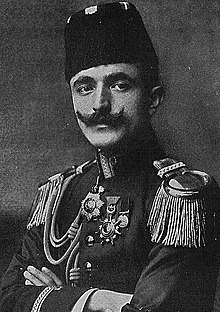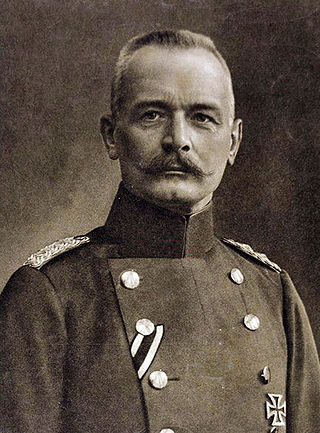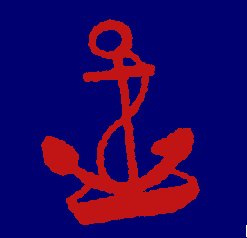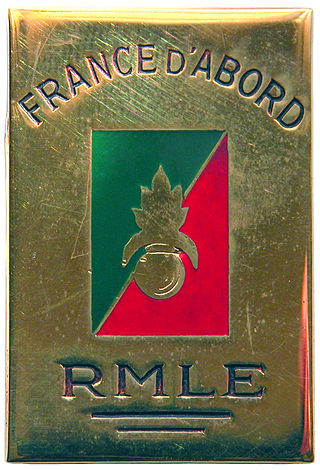Central Powers

- Ottoman Empire: Deputy commander-in-chief (Başkomutan Vekili) Enver Pasha (1914–1918)
Commanders:
The list of commanders in the Middle Eastern theatre of World War I gives the engagements and the respected officers during the conflicts.

Commanders:

Commanders:
The British Expeditionary Force (BEF) was the six-divisions the British Army sent to the Western Front during the First World War. Planning for a British Expeditionary Force began with the 1906–1912 Haldane Reforms of the British Army carried out by the Secretary of State for War Richard Haldane following the Second Boer War (1899–1902).
The Stavka is a name of the high command of the armed forces formerly in the Russian Empire, Soviet Union and currently in Ukraine.

General Erich Georg Sebastian Anton von Falkenhayn was the second Chief of the German General Staff of the First World War from September 1914 until 29 August 1916. Falkenhayn was removed on 29 August 1916 after the failure of his offensive strategy in the west at the Battle of Verdun, the opening of the Battle of the Somme, the Brusilov Offensive and the Romanian entry into the war. Having planned to win the war before 1917, the German army was reduced to hanging on.

Ludwig Alexander Friedrich August Philipp Freiherr von Falkenhausen was a German officer most notable for his activities during World War I.

A Generaloberst was the second-highest general officer rank in the German Reichswehr and Wehrmacht, the Austro-Hungarian Common Army, the East German National People's Army and in their respective police services. The rank was equal to a four-star full general but below a general field marshal. The rank was equivalent to a Generaladmiral in the Kriegsmarine until 1945 or to a Flottenadmiral in the Volksmarine until 1990. It was the highest ordinary military rank and the highest military rank awarded in peacetime; the higher rank of general field marshal was awarded only in wartime by the head of state. In general, a Generaloberst had the same privileges as a general field marshal.

The 1st Army was an army-level command of the Russian Imperial Army created during World War I. The First Army, commanded by General Paul von Rennenkampf, invaded East Prussia at the outbreak of war in 1914 along with the Second Army commanded by General Alexander Samsonov. After declaring war on the German Empire, the Russian Empire had been able to mobilize very quickly. All Russian forces were put under the command of Grand Duke Nikolai and his Quartermaster General Yuri Danilov.

Field Marshal Philip Walhouse Chetwode, 1st Baron Chetwode, 7th Baronet of Oakley,, was a senior British Army officer. He saw action during the Second Boer War, during which he was present at the Siege of Ladysmith in December 1899. He saw action again during World War I on the Western Front, taking part in the First Battle of Ypres, and then in the Sinai and Palestine campaign during which he led his corps at the First Battle of Gaza in March 1917, at the Battle of Beersheba in October 1917 and the Battle of Jerusalem in November 1917.

Mikhail Vasilyevich Alekseyev was an Imperial Russian Army general during World War I and the Russian Civil War. Between 1915 and 1917 he served as Tsar Nicholas II's Chief of Staff of the Stavka, and after the February Revolution, was its commander-in-chief under the Russian Provisional Government from March to May 1917. He later played a principal role in founding the Volunteer Army in the Russian Civil War and died in 1918 of heart failure while fighting the Bolsheviks in the Volga region.

The Allies, or the Entente Powers, were an international military coalition of countries led by France, the United Kingdom, Russia, the United States, Italy, and Japan against the Central Powers of Germany, Austria-Hungary, the Ottoman Empire, and Bulgaria in World War I (1914–1918).

The Allied leaders of World War I were the political and military figures that fought for or supported the Allied Powers during World War I.

The Royal Australian Naval Bridging Train was a unique unit of the Royal Australian Navy. It was active only during the First World War, where it served in the Gallipoli and the Sinai and Palestine Campaigns. The Train was formed in February 1915 and stood down in May 1917. Throughout its existence, it was composed of Royal Australian Naval Reservists under the command of Lieutenant Commander Leighton Bracegirdle. Normally under the command of the British IX Corps, the Train also supported the I ANZAC Corps and Imperial Camel Corps in the defence of the Suez Canal.
They were the only Australian naval unit serving in a European theatre of war. They were therefore bent on proving, both to the Royal Navy and to the British Army, that they could overcome any difficulties.
The air commanders of World War I were army or navy officers who came to command air services during the first major conflict in which air power played a significant role.
Generalleutnant Walter von Hippel (Luftwaffe) (27 May 1897 – 29 November 1972) was a general in the Luftwaffe of Nazi Germany during World War II who commanded several flak divisions. He was also a recipient of the Knight's Cross of the Iron Cross.

Afrikan Petrovich Bogaewsky or Bogayesky was a Russian military leader from the Don Cossack noble family of Bogaewsky. He served as a lieutenant general in the Imperial Russian Army and also served as the ataman of the Don Republic.

General Officers of World War I is an oil painting by John Singer Sargent, completed in 1922. It was commissioned by South African financier Sir Abraham Bailey, 1st Baronet to commemorate the generals who commanded British and British Empire armies in the First World War.

Naval Officers of World War I is a large oil on canvas group portrait painting by Sir Arthur Stockdale Cope, completed in 1921. It was commissioned by South African financier Sir Abraham Bailey, 1st Baronet to commemorate the Royal Navy officers who commanded British fleets in the First World War. Cope's painting was first exhibited at the Royal Academy summer exhibition in 1921 and donated to the National Portrait Gallery that year.

The leaders of the Central Powers of World War I were the political or military figures who commanded or supported the Central Powers.
The Austro-Hungarian Fifth Army was an Austro-Hungarian field army that fought during World War I.

The Marching Regimentof the Foreign Legion (RMLE) was a French military unit that fought in World War I and World War II. Initially composed of marching regiments from the 1st Foreign Regiment of Sidi Bel Abbes and the 2nd Foreign Infantry Regiment of Saida, Algeria, it re-formed as the 3rd Foreign Infantry Regiment.